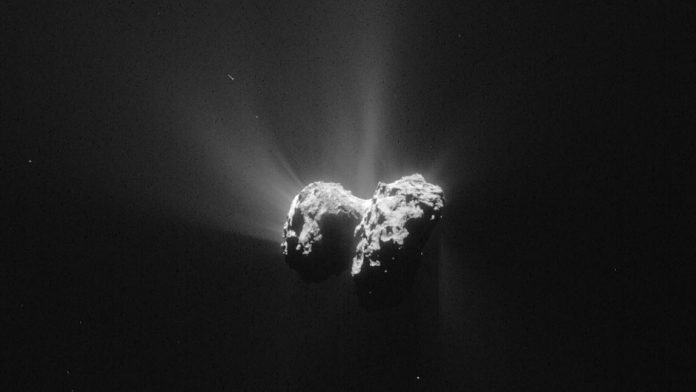Philae and Rosetta have been on an 10-year mission to get to the surface of Comet 67P/Churyumov-Gerasimenko. In November 2014, Rosetta, a comet orbiter, became the first spacecraft to orbit a comet. After 3 months gathering data from orbit, she released Philae, a comet lander and her partner in exploration, to attempt to land on the comet’s surface. Although he did touch down, all was not as planned for Philae.
Philae makes contact on the surface of Comet 67P/Churyumov-Gerasimenko, Photo courtesy of ESA/Rosetta/Philae/CIVA
After making contact, his harpoons, designed to keep him anchored at his landing site, failed to fire, and he drifted off the surface in high arcs, bouncing into the shadows before coming to a rest.
This was not good news for little Philae. He was the first spacecraft ever to successfully land on a comet, but had only 60 hours to learn as much as he could before he would lose power. He completed all the early tests he had planned before initiating a program for hibernation. In the shadows of the comet, without access to sunlight to recharge his solar powered batteries, researchers did not know whether he would survive the extreme cold (as low as -150°C).
There was a chance that, as the comet approached the sun, that Philae would see sunlight again and wake up. The world waited.
Rosetta and Philae’s mission to land on Comet 67P/Churyumov-Gerasimenko; Animation courtesy of ESA
This month, on June 14, 2015, Philae woke up and had enough power to send a signal back up to Rosetta, who had been waiting for him to call. She immediately started to transmit data back to researchers back on Earth.
As noted in this CBC news article, this adventure could be a lucky accident for science. We’re still searching for Philae, but the great news is that he survived his time in the shadows and will now be collecting data while the comet is reaching its closest approach to the sun, and is therefore more active. Had he stayed in his originally planned sunny location, temperatures would have soared to over +150°C by now, and he would have been cooked by the end of 2014.
To learn more about Comet 67P/Churyumov-Gerasimenko, have a look at the infographic below.
Anatomy of Comet 67P/Churyumov-Gerasimenko, Image courtesy of ESA
All images courtesy of ESA, (Including the Feature Image, Copyright: ESA/Rosetta/NAVCAM – CC BY-SA IGO 3.0)










































